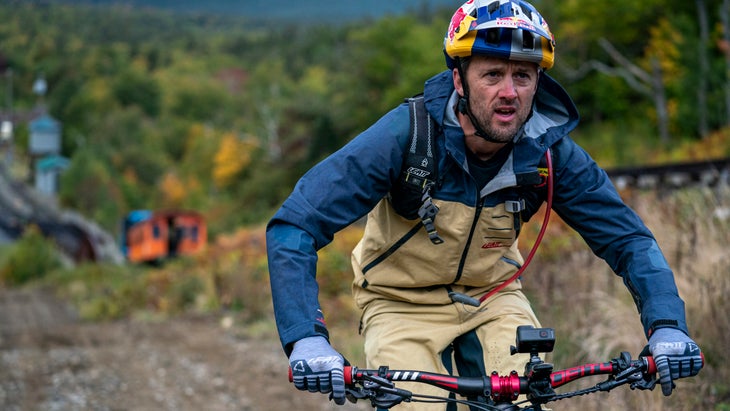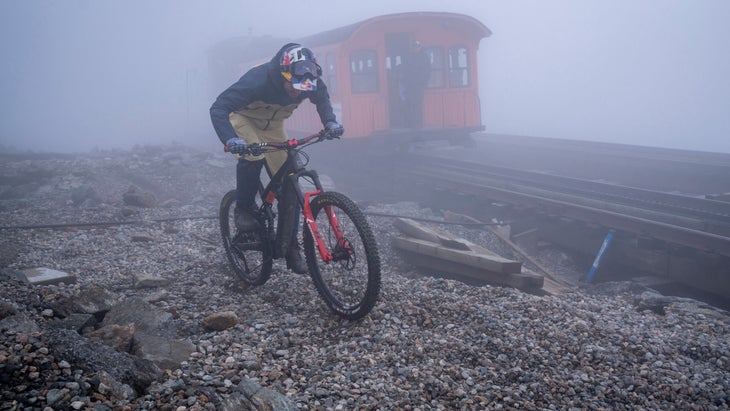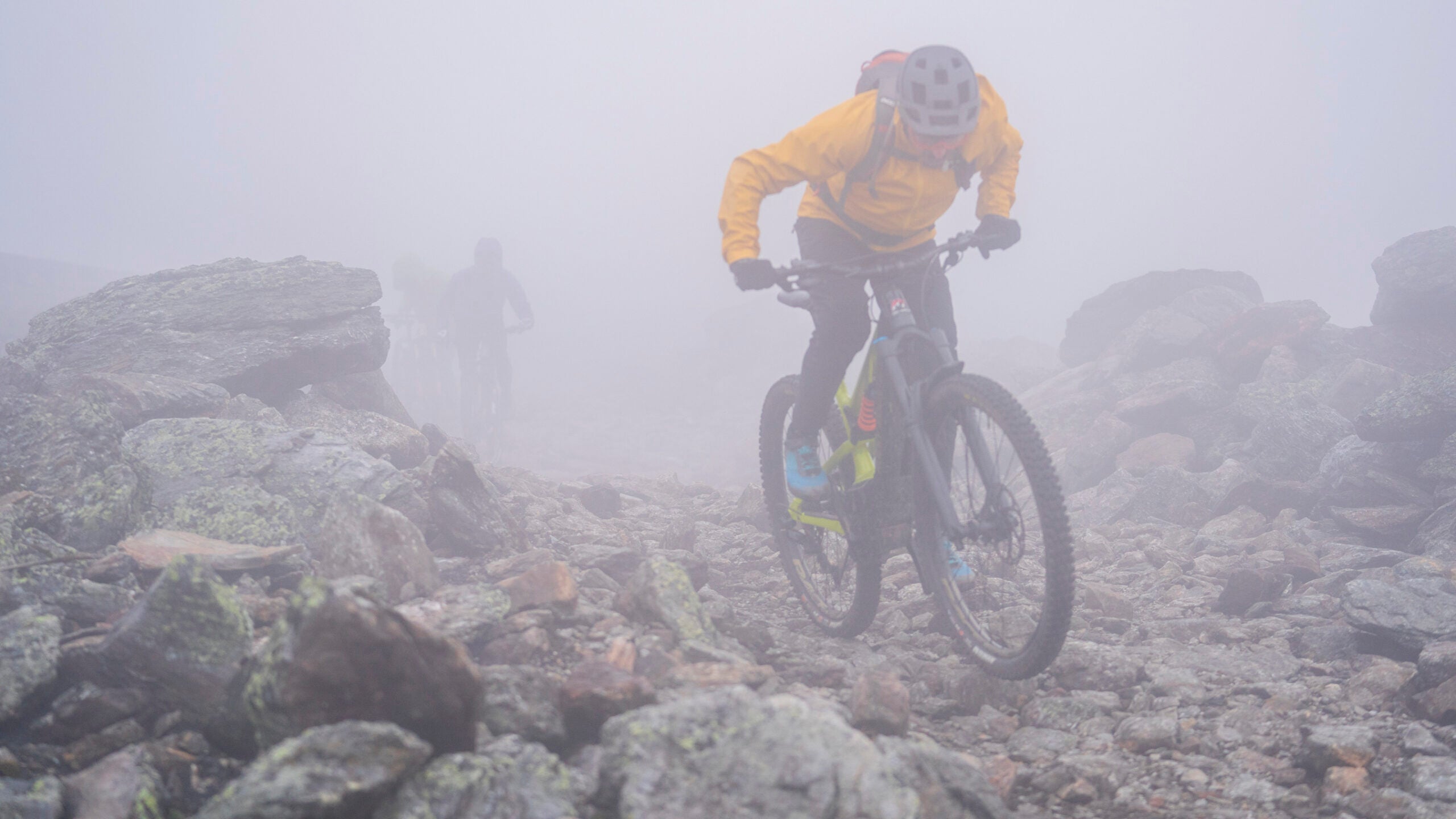I had seen my fair share of starting lines at bike races, but what I saw on September 27 in New Hampshire was something completely different. To my right were four pro-level freeride mountain bikers on e-mountain bikes. To my left was a massive biodiesel train engine, capable of generating 600 horsepower and 30,000 pound-feet of torque.
We were at the base of 6,288-foot Mount Washington, the tallest peak in the Northeast, and our objective was to race our motor-assisted bicycles to the top before the train got there. Our course was a rugged work road next to the narrow-gauge tracks of the famous Mount Washington Cog Railway. The route was three miles from start to finish, with an average steepness gradient of more than 25 percent and a vertical rise of roughly 3,500 feet. The train can make the trip to the top in 36 minutes. Did we mere mortalsŌĆöaided by pedal-assist bikes with 250-watt motorsŌĆöstand any chance of getting to the summit before the locomotive? I was skeptical.
So was , 42, the organizer of this unorthodox race, which he has tentatively named MOB vs. COG. Chase has been a professional mountain biker since he graduated from high school in Belmont, New Hampshire, in 1997. Over the decades, he transitioned his riding from and dual slalom to slopestyle and . These days, Chase almost exclusively rides an e-mountain bike, using it to do multiple laps at his local haunt, , and to go for epic rides in terrain where few would want to ride.

Chase has become a sort of evangelist for e-mountain bike technology. One of his converts is his longtime friend Jeff Lenosky, a professional trials rider. Chase took Lenosky on his first e-mountain bike ride last summer, on some in North Conway, New Hampshire, and Lenosky marveled at how the motorized bikes ascended seemingly impossible climbs.
ŌĆ£One of the things I really enjoy doing when I trail ride is to try to climb the unclimbable, the real tech challenges,ŌĆØ Lenosky said. ŌĆ£The stuff that Aaron was doing on an e-bike took that to a whole different level. We went way beyond what I thought was possible, using our skills and a little extra watts to do these crazy impossible climbs and get out to these destinations that we wouldnŌĆÖt have been able to pedal to in a day.ŌĆØ
The spirit of riding crazy impossible climbs is what brought Chase, along with pro freerider Peter Ostroski and local hitters Brian Moody and Kevin Sweeney, to the cog railway to challenge the train. I had met Chase last spring during a writing project, and he told me his idea for the challenge. Chase recruited us to do a recon lap up the mountain as a proof-of-concept trial for an event that he hopes will someday attract an international field of top-level e-mountain bike racers. He envisages a mass-start race that has the exciting elements of, say, the MegavalancheŌĆöthe zany, mass-start enduro race made popular by ŌĆöbut with the bonus of safety.
ŌĆ£That downhill is super exciting but very dangerous,ŌĆØ Chase explained. ŌĆ£This flips that on its head. YouŌĆÖve got the urgency of the cog chasing you down, and you need ninja e-bike skills to balance and maintain traction on the steep course. So it gets your heart racing without putting you in dire jeopardy of crashing.ŌĆØ
I was curious if this bizarre event could pen a new chapter into the short history of e-bike racing. Thus far, racing on pedal-assist bikes has been mostly derivativeŌĆöriding courses that traditional bicycles could negotiate, only doing it faster while managing battery life. The Sea Otter Classic in 2016 held the first large-scale e-bike race, using a 1.5-mile course on the grassy hills around the festival. Former cross-country mountain bike world champion Christoph Sauser won the race.
In 2019, the first took place in Mont-Sainte-Anne, Canada, on a course like the one used during the conventional cross-country event.
In Europe, where e-biking is much more pervasive, nearly every bike race now features an e-bike category, including enduros, , and the famed Giro dŌĆÖItalia, which supports a tourism event called .
There is something appealing about ChaseŌĆÖs wacky idea, pitting machine-augmented humans against a slow train climbing a big mountain. It certainly isnŌĆÖt derivative, since thereŌĆÖs no event like this for conventional bikes. In fact, a regular bike would be useless on this courseŌĆöthe track is far too steep and long to climb with muscle power alone.
The 151-year-old was the brainchild of inventor Sylvester Marsh, who came up with the idea in 1852 while hiking the mountain and then pitched it to the state legislature as a way to attract tourists to the north country. The steam locomotive that climbed the track used a large cog whose teeth mesh with a fixed chain-like groove between the trackŌĆÖs rails. When the cog opened in the summer of 1869, it became the first mountain-climbing cog railway in the world.
Chase got permission for us to race it up the hill by promising authorities that we would do it early in the morning, before tourists showed up. The conditions at the start were cool and calm, but the summit was below freezing, with a windchill of 17 degrees. When the race started, Ostroski rocketed off the line and was out of sight after a few minutes. Within the first quarter-mile, I was off the bike and pushing it, the loose, gravelly surface being too tricky for me to navigate on the full-suspension Commen├¦al e-bike I borrowed from Chase.
I hopped on and off the bike a few times, riding it where I could and walking where my XC-oriented skills failed me. When I could pedal, I was moving at about five or six miles per hour. When walking, my speed was more than cut in half, and I could see the train hunting me down. It passed me just before the Waumbek water tank, where the steam engines stop to fill up their tenders, at about 3,800 feet. I hadnŌĆÖt even made it halfway before deciding to turn around.

The rest of the crew fared much better. They were able to ride most of the climb before the steepest part, , where they had to hike-a-bike for about 15 minutes. Then they could ride again for the final third of the journey. They reached the cold, fog-shrouded summit in about 70 minutes. But all of us were caught and passed by the train. After having a snack and taking some photos at the visitor center on top, the quartet blasted back down the mountain in a mere ten minutes, stopping once to let their disc brakes cool.
Despite losing to the train, our efforts provided valuable reconnaissance for Chase. He learned that the left side of the tracks (before JacobŌĆÖs Ladder), with its coating of fresh gravel, was too loose a surface for the bikes. The right side, while bumpier, had better traction and was faster to ride. And Chase learned that the antique steam engine, which still makes trips every day, takes about 65 minutes to get to the summit. That puts skilled riders within five minutes of the trainŌĆöclose enough that a few improvements to the track could make the race a nail-biter.
In ChaseŌĆÖs view, the ancient locomotive engine adds an exciting steampunk vibe to the event, with the smokestack leaving a billowing cloud in its wake. In his vision, someday the train car will be full of photographers and support teams, and the announcer will be calling the race as the train gets closer and closer to the riders.
ŌĆ£When it does pass people, itŌĆÖs spitting out cinders and black soot, and it might even be raining down on them, depending on which way the wind is blowing,ŌĆØ Chase said. ŌĆ£You just want to stay in front of that train, and when it passes you, itŌĆÖs going to feel like itŌĆÖs about to eat you up.ŌĆØ
If thatŌĆÖs the future of e-mountain bike racing, bring it on.


